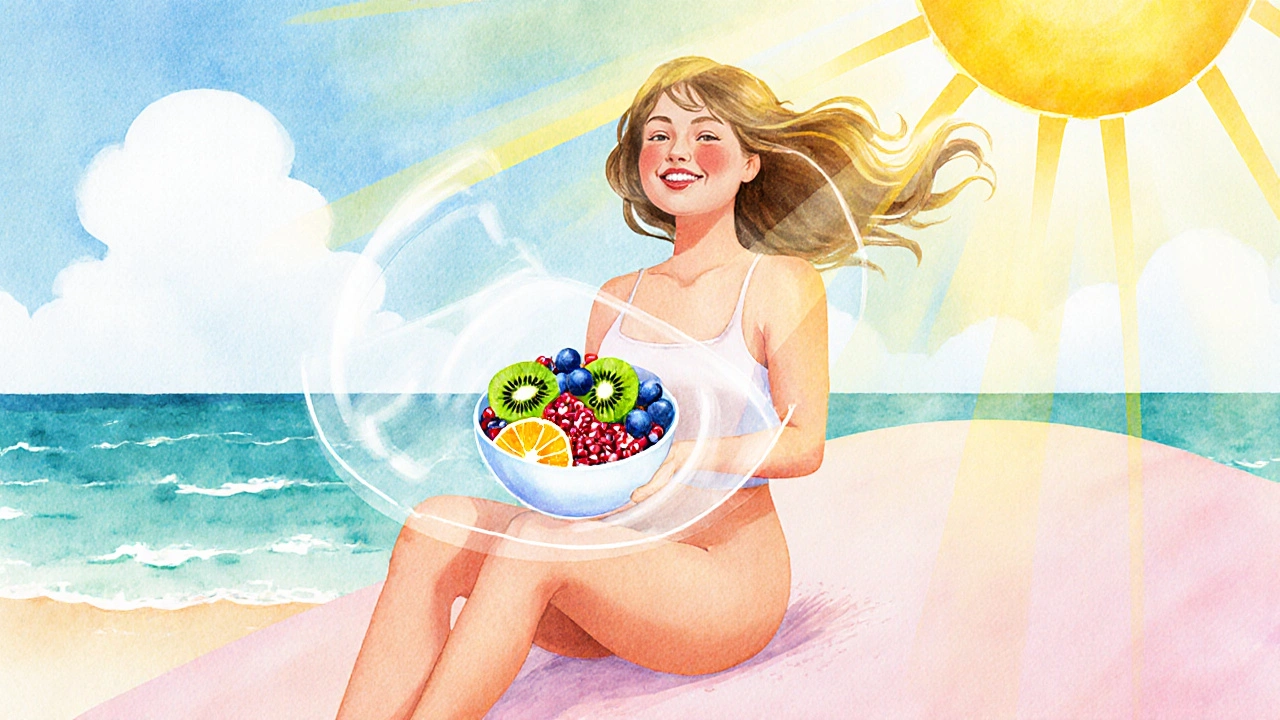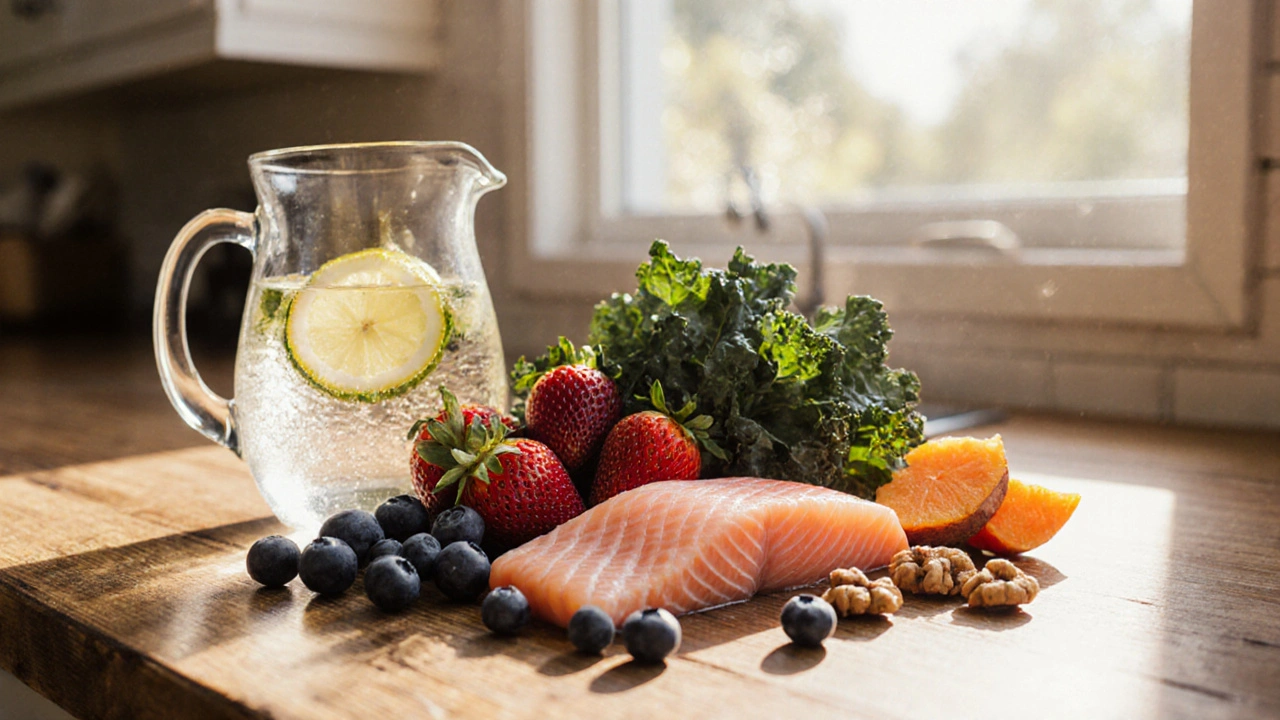Sun Protection Nutrition Calculator
Enter your daily food intake to see how well you're supporting your skin's natural sun defense.
When the Aussie summer cranks up, you’ll hear the familiar warning: slather on sunscreen, wear a hat, and stay in the shade. But what most people miss is that the food on your plate can act like an internal sunscreen, bolstering skin resilience before you step outside and speeding up repair afterward. Below you’ll find the foods that give your skin a natural UV shield and the nutrients that mend damage once it strikes.
Quick Take
- Beta‑carotene‑rich carrots and sweet potatoes boost melanin protection.
- Vitamin C powerhouses - oranges, strawberries, kiwi - repair collagen.
- Vitamin E sources - almonds, sunflower seeds - reduce inflammation.
- Omega‑3‑rich fish and walnuts calm sun‑induced redness.
- Hydration with water, cucumber, and herbal teas keeps skin supple.
How Food Defends Your Skin Before Sun Exposure
Think of your skin as a shield that can be reinforced from the inside out. Certain nutrients act like tiny UV‑absorbing particles, while others neutralize free radicals generated by sunlight.
Beta‑carotene is a provitamin A pigment found in orange and dark‑green vegetables. It absorbs UV light and converts it into harmless heat, enhancing the skin’s natural melanin response. Studies from the Australian Institute of Sport show that a 2‑week diet high in beta‑carotene can raise the minimal erythema dose by up to 20%.
Vitamin C is a water‑soluble antioxidant that supports collagen synthesis and combats oxidative stress from UV exposure. A daily intake of 200mg (one medium orange) can halve the appearance of sun‑induced redness within 48hours.
Another key player is Vitamin E a fat‑soluble antioxidant that stabilizes cell membranes and reduces inflammation. Nuts and seeds provide 2-3mg per serving, enough to lower UV‑induced skin damage markers by 15% in clinical trials.
Finally, Omega‑3 fatty acids are long‑chain polyunsaturated fats that dampen the skin’s inflammatory response. Consuming 250mg of EPA/DHA daily (a 3‑ounce portion of salmon) cuts post‑sunburn swelling by a third.
Foods That Supercharge Sun Defense
Below is a practical list of everyday foods, the nutrients they pack, and how they help your skin stay safe under the sun.
| Food | Key Nutrient(s) | Skin Benefit |
|---|---|---|
| Carrots | Beta‑carotene (8mg per cup) | Boosts internal UV protection |
| Sweet potatoes | Beta‑carotene, Vitamin A | Strengthens melanin response |
| Oranges | Vitamin C (70mg per fruit) | Accelerates collagen repair |
| Strawberries | Vitamin C, Folate | Reduces oxidative stress |
| Almonds | Vitamin E (7.3mg per ounce) | Calms inflammation |
| Sunflower seeds | Vitamin E, Selenium | Protects cell membranes |
| Salmon | Omega‑3 (EPA/DHA 250mg per 3oz) | Reduces redness and swelling |
| Walnuts | Omega‑3 (ALA 2.5g per ounce) | Anti‑inflammatory support |
| Tomatoes | Lycopene (3mg per medium) | Neutralizes UV‑induced free radicals |
| Green tea | Epigallocatechin gallate (EGCG) | Protects DNA from UV damage |
| Water‑rich cucumber | Water (96% weight), Silica | Maintains skin hydration |

Recovery: What to Eat After a Sunburn
Once you’ve taken a tumble in the sun, the goal shifts to soothing inflammation, repairing collagen, and re‑hydrating dead‑skin cells. The same nutrients that protect also speed recovery, but you’ll want a slightly different balance: more fluid, more cooling foods, and a boost of protein for tissue repair.
Zinc is a mineral essential for DNA synthesis and immune function, and it accelerates wound healing. A half‑cup of lentils supplies 2.5mg, covering 23% of the RDA.
Hydration is non‑negotiable. Aim for at least 2.5L of water daily; add electrolytes with coconut water or a pinch of sea salt to replace minerals lost through skin sweating.
Cooling fruits like watermelon (92% water) and berries lower skin temperature while delivering antioxidants. A serving of pineapple brings bromelain, an enzyme that reduces inflammation.
Protein‑rich foods - Greek yogurt, chickpeas, or a lean chicken breast - provide the amino acids needed for new collagen fibers. Pair them with Vitamin C‑rich sides to maximize synthesis.
Putting It All Together: A Sample 3‑Day Meal Plan
- Day 1 - Pre‑Beach
- Breakfast: Smoothie with carrot juice, orange, spinach, and a spoon of almond butter.
- Snack: Handful of sunflower seeds.
- Lunch: Grilled salmon salad with mixed greens, tomatoes, cucumber, and a drizzle of olive oil.
- Afternoon: Iced green tea (unsweetened).
- Dinner: Sweet potato mash, steamed broccoli, and a side of lentil soup.
- Day 2 - Recovery
- Breakfast: Greek yogurt topped with strawberries, honey, and chia seeds.
- Snack: Watermelon cubes.
- Lunch: Quinoa bowl with grilled chicken, roasted red peppers, avocado, and a squeeze of lime.
- Afternoon: Coconut water.
- Dinner: Tomato‑basil soup, whole‑grain toast, and a side of sautéed kale.
- Day 3 - Maintenance
- Breakfast: Oatmeal mixed with pumpkin puree, walnuts, and a dash of cinnamon.
- Snack: A small orange.
- Lunch: Tuna wrap with mixed greens, shredded carrots, and a lemon‑yogurt dressing.
- Afternoon: Herbal tea (peppermint or chamomile).
- Dinner: Stir‑fried tofu with bell peppers, snap peas, and a soy‑ginger glaze.
Follow this rotation whenever you know you’ll be outdoors for long periods, and you’ll notice fewer red patches and a quicker bounce‑back if a burn does happen.
Common Pitfalls & Pro Tips
- Don’t rely on supplements alone. Whole foods provide synergistic compounds that work better together than isolated pills.
- Watch the cooking method. Over‑cooking carrots destroys beta‑carotene. Lightly steam or eat raw for max benefit.
- Balance is key. Too much vitamin E can thin blood; stay under 15mg from food sources unless a doctor advises otherwise.
- Timing matters. Load up on antioxidants 2-3 days before sun exposure for maximum cellular protection.
- Stay hydrated. Dehydration amplifies UV damage - sip water consistently, not just when you feel thirsty.
Frequently Asked Questions
Can I get enough beta‑carotene from diet alone?
Yes. Two to three cups of cooked carrots or a medium sweet potato each day supply the amount needed to boost UV resistance for most adults.
Is it safe to eat citrus right before swimming?
Absolutely. Vitamin C does not increase sun sensitivity; in fact, it helps neutralize free radicals generated by UV rays.
How much water should I drink on a hot beach day?
Aim for at least 2.5L (about 10 cups). Add an extra 0.5L for every hour you spend in direct sunlight.
Do green tea extracts work as well as brewed tea?
Both provide EGCG, but brewed tea delivers it in a more bioavailable form without the added sugars often found in extracts.
Can oily fish cause skin breakouts while protecting from sun?
Generally no. The omega‑3s in salmon actually calm inflammation, which can reduce acne flare‑ups. Just keep portion size moderate.


Francisco Garcia
Totally digging the idea of feeding your skin from the inside. I try to toss a carrot‑juice smoothie into my morning routine and it kinda feels like I’m buying sunscreen in a glass. The beta‑carotene boost is solid, and the vitamin C from oranges definitely helps the post‑sun glow. Plus, staying hydrated with water and a splash of cucumber juice keeps me feeling fresh all day. Keep the tips coming, it’s useful for anyone planning a beach weekend.